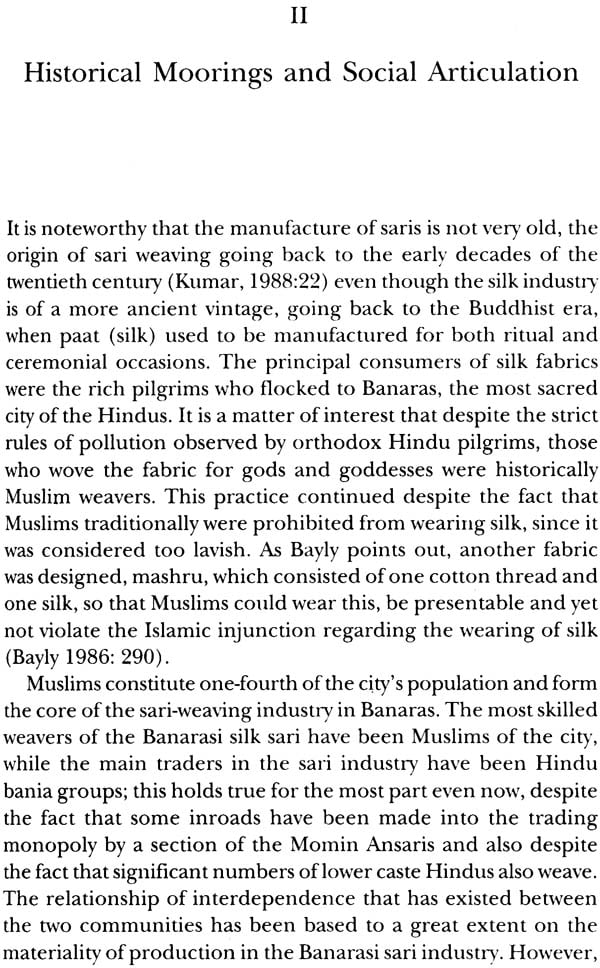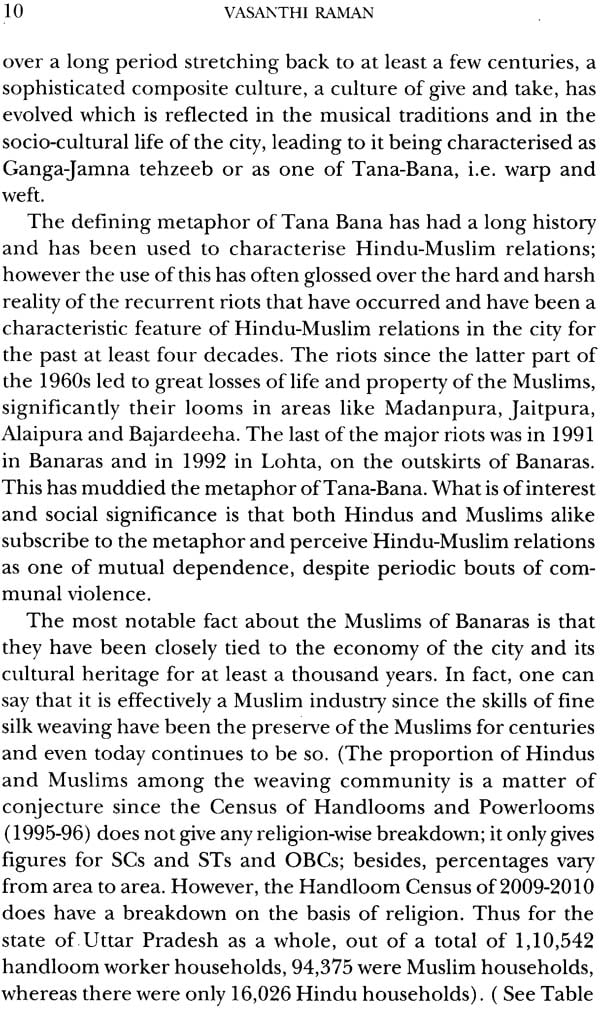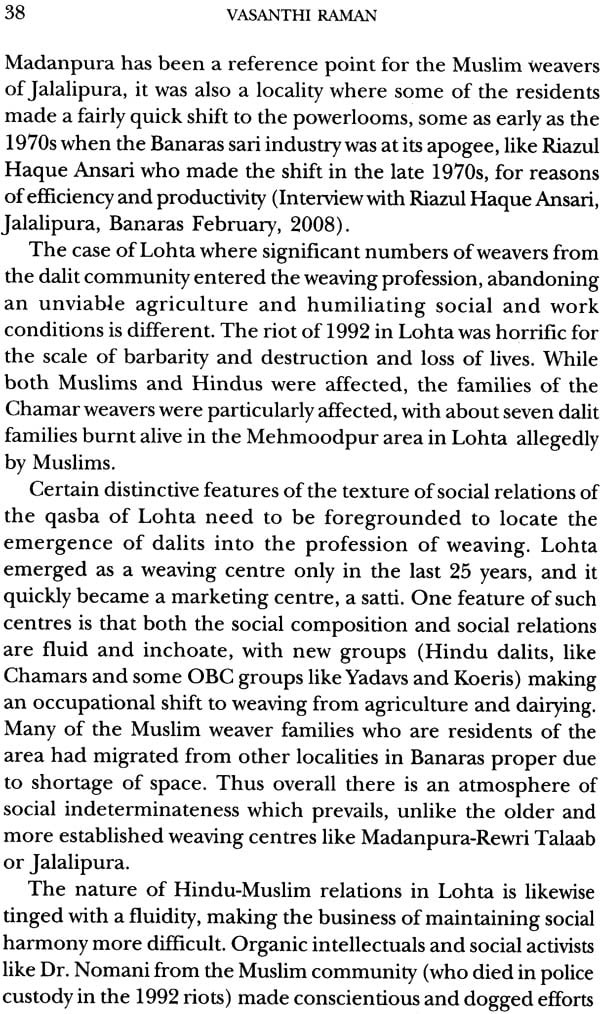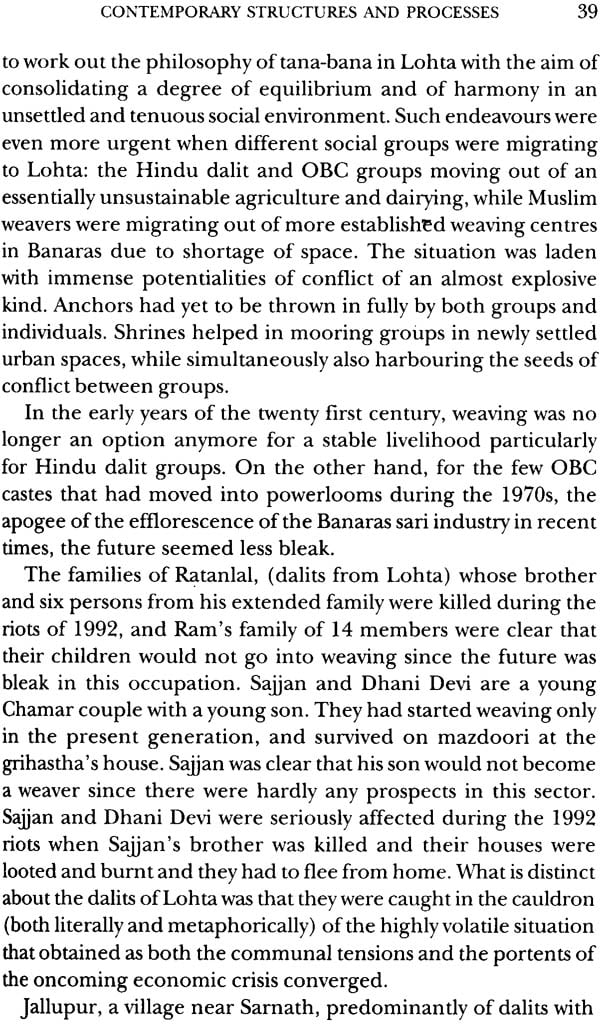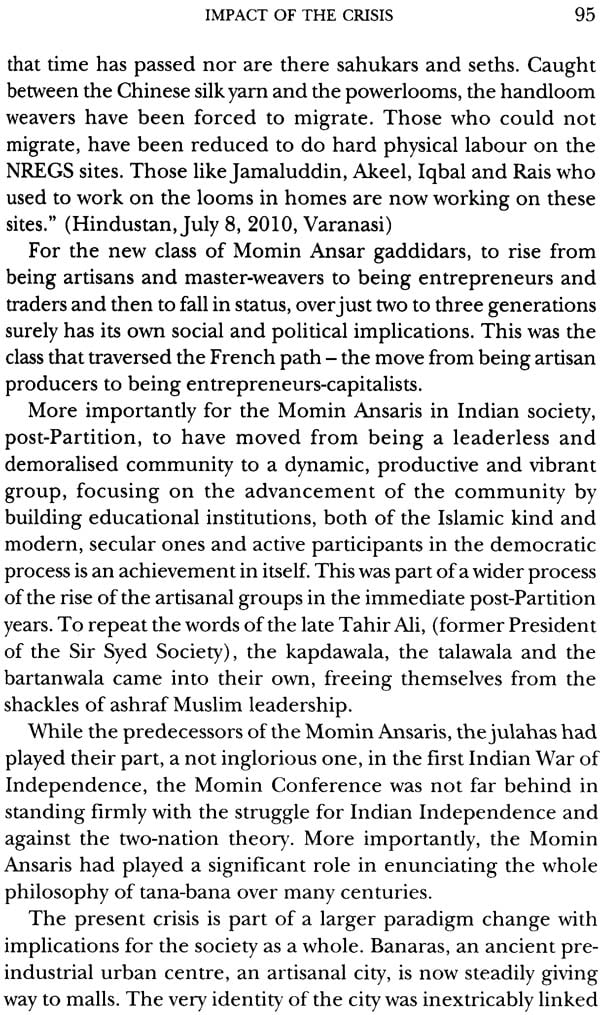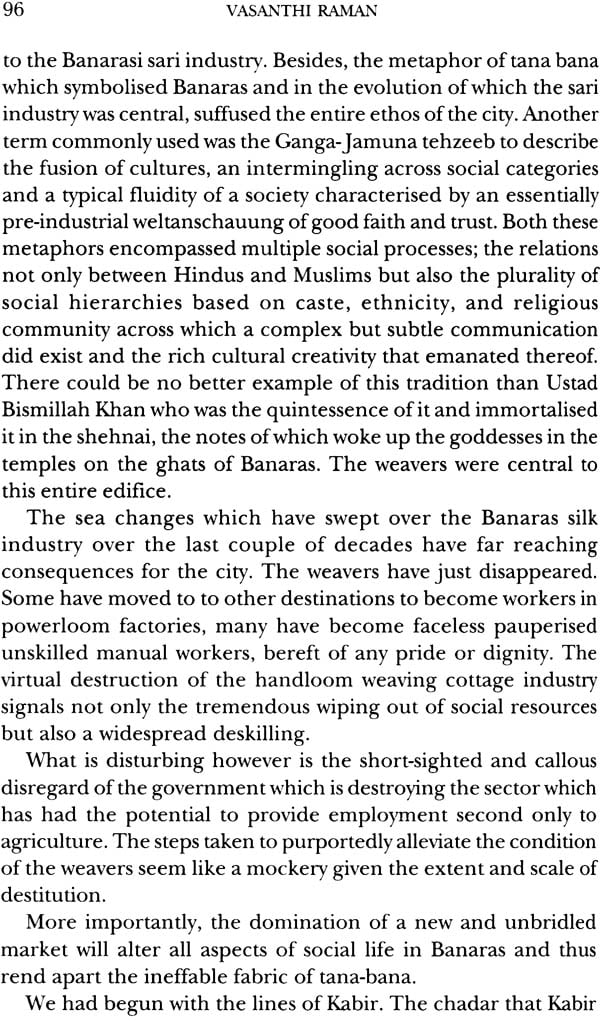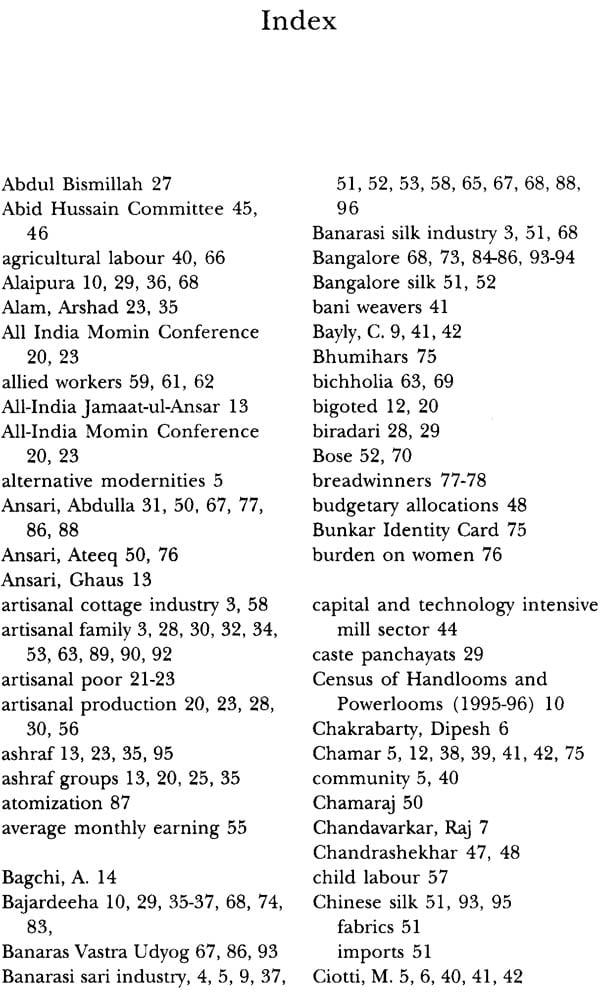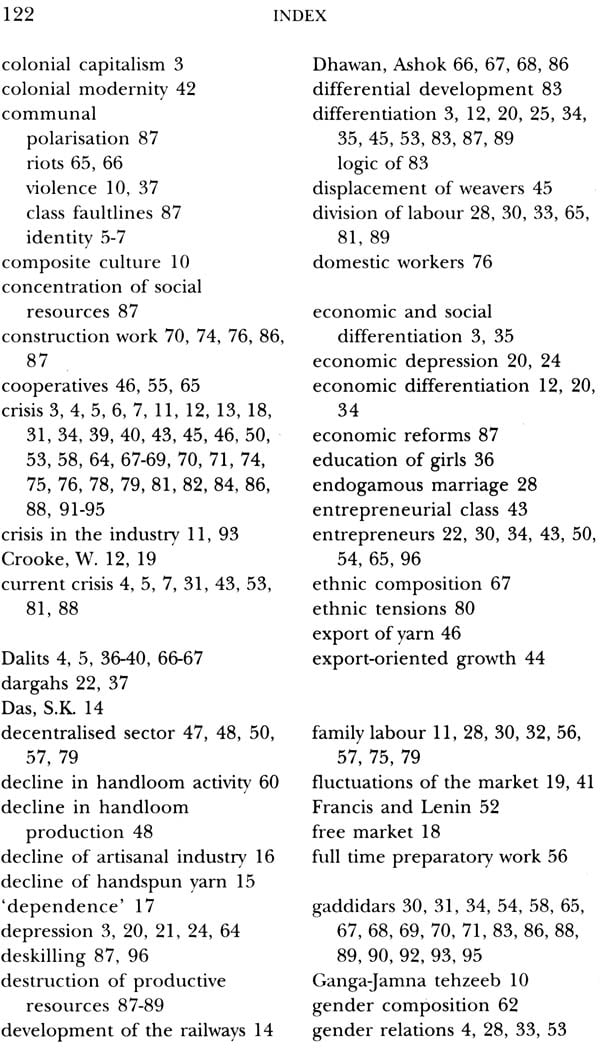
Entangled Yarns (Banaras Weavers and Social Crisis)
Book Specification
| Item Code: | NAH529 |
| Author: | Vasanthi Raman |
| Publisher: | Indian Institute of Advanced Study, Shimla |
| Language: | English |
| Edition: | 2013 |
| ISBN: | 9789382396000 |
| Pages: | 136 |
| Cover: | Hardcover |
| Other Details | 8.5 inch x 5.5 inch |
| Weight | 290 gm |
Book Description
The book focuses on the crisis that visited the world of the Banaras weavers during the last two decades. The author traces the genealogy of both, the crisis and the weavers. The weavers' historical journey from being ordinary low caste julahas to conversion to Islam and their becoming Momin Ansaris is an important milestone in their social and historical voyage. However, despite conversion, continuous and long term relations with other social groups and castes, including Hindu merchants constituted a significant component of their social existence and experience. The complex and tortuous relations between Muslims and Hindus over centuries not withstanding, a metaphor drawn from weaving-tana. bana has evolved which has defined the texture of the weaving industry as well as contributed to a composite culture.
, The colonial period marks a significant rupture which fractured the social cohesion that marked their world and eroded the ideal of the self-employed independent artisan. The partition of the subcontinent was another agonising watershed. The last two decades were decisive in culminating a process begun in the early years of colonial capitalism wherein the global has impacted the local with irrevocable . consequences. The book focuses on the impact of the crisis on weavers and their families. The author foregrounds intercommunity relations which are embedded in and intertwined with the relations of production in the artisanal cottage industry and the gender relations which are integral to it. Combining social history, rich ethnographic fieldwork and analysis of current economic policies and their impact, the book should interest scholars in these diverse fields. It is a detailed social document of the plight of the weavers as they face near extinction as an artisanal community.
Vasanthi Raman did her Masters and doctorate in Sociology at the University of Mumbai. She was Professorial Fellow at the Centre for Women's Development Studies, Delhi between 1996 and 2010 and Visiting Fellow between April 2011 and July 2012. She was also a Fellow at the Indian Institute of Advanced Study, Shimla between 2007 and 2009. She has been Visiting Professor at the University of Joensuu, Finland in February-March 2009 where she taught a course in Ethnicity, Religion and Gender. She was a member of the Indian Council of Social Science Research between 2008 and 2011. Currently she is professor at the Department of Women's Studies at the Mahatma Gandhi International Hindi University, Wardha.
She has published research papers on a wide range of themes, which include communalism and the construction of gender and Hindu-Muslim relations, childhood studies, issues of transition of tribal communities and gender and ethnicity. Her book-The Warp and the Weft: Community and Gender Identity Among Banaras Weavers was published by Routledge in 2010.
Cloth has, since the earliest periods of human history, symbolised the essence of social relations as well as articulated the relationship between human beings and the domain of the sacred. The metaphor of cloth has often been used to describe the content and texture of human social relations but as has been pointed by Schneider and Weiner (1989) social scientists have not only confined themselves to describing and analysing social connectedness but also the softness and fragility of the materials which reflect and capture the frailty and the transient nature of the human condition, subject to the degenerative processes of illness, decay and death (Weiner and Schneider 1989:2).
The philosopher-saint of the weavers, Kabir uses another metaphor, that of the body and its cosmic dimensions and compares the cloth that is woven to the three nerves, eight grooves, the five elements and three gunas (qualities or essences). He highlights the sacred nature of the cloth woven and the profane manner in which it is used by humans and contrasts it with his own devotion and surrender to the Almighty.
Kahe ka tana kahe ki bharni
Kaun taar se beeni chadariya
Ingla pingla tana bharni
Sukhman taar se beeni chadariya
Aatth kamal dal charkha dole paanch lat gun beeni chadariya
So chadar sur nar muni oddhe,
Oddhke maili keeni chadariya
Das Kabir jatanse oddhi jyon ki tyon ghar deeni chadariya
He spins in delicate and airy weaves
And what kind of thread the body is knit
The fabric thus woven is made of
Three nerves (Ingla, Pingla and Sukhman)
The wheels rotate round eight grooves
Of lotus, the five elements and the three gunas
And it has taken him exactly ten months
Of toil and craft to hands pin this yarn
This cloth wraps itself around the bodies of
Gods, men and sages, yet all soil (dirty) it
It is only your slave Kabir who wears it with care;
And returns it to you as it was.
Kabir - Translated by Nandini Chandra
In a sense, Kabir's use of the metaphor of cloth woven by weavers not only emphasizes the sacred and ethereal dimension of cloth but also touches on the supremely social dimension of it. This in a sense is what Weiner and Schneider (1989) point out when they state that to "seek the symbolic potentialities of cloth in their material properties is only a preliminary step" and only partially compelling" (Weiner and Schneider 1989:3). The human action that make cloth politically and socially salient are equally important (Weiner and Schneider 1989:3). Cloth is used to both consolidate social relations and mobilise political power.
The story of Kabir's progeny, the julahas of Banaras is what we wish to narrate in the following pages. We trace their origins as humble weavers, weaving cloth for the rich and the mighty as well as for the poor, their long journey over many centuries and their attempt to transcend their lowly and despised status in a hierarchical Hindu social order by conversion to Islam. Their ascent to the status of Mom in Ansaris, their careful and meticulous cultivation of the most prized skills, their pride in their status as artisans and their desperate attempt to cling to the elusive ideal of the independent artisan over the last two centuries is an integral part of the story. During this long journey, they also interacted with other social groups and castes who also became part of the weaving brotherhood over time, groups who were lowly groups of the Hindu social order as well as the merchant groups who historically have been Hindus and with whom they had a very complex and tortuous relationship of dependence and exploitation. The operation of macro socio-economic forces during the colonial period resulted in the fracturing of their social cohesion through economic and social differentiation, leading to the emergence of classes among them. The divergent political articulations and assertions during the critical decades of the 1920s and 1930s, when the depression further impacted their world with lasting consequences, is a major milestone in their historical journey. The partition of the subcontinent was yet another milestone posing agonising dilemmas as well as offering opportunities.
The last years of the twentieth century were decisive since it culminated in a process begun in the early years of the nineteenth century with the penetration of colonial capitalism. And finally the end of the world of the julahas during the fin de siecle, when global capitalism came as a cataclysmic visitation spelling doom for the world of the julahas as it existed till recent times.
The present monograph deals with the impact of the crisis since the latter part of the 1990s on the families of the weavers when many macro processes converged to alter the worlds and lives of the weavers irrevocably. The focus is on the consequences for the family since the artisanal family has been the locus of the weaving industry. An important and continuing element of the Banarasi silk industry is that the relations between Hindus and Muslims is embedded in and intertwined with the relations of production in this artisanal cottage industry. The manner in which these relations have transformed over different phases of the evolution of the industry also constitutes a significant context within which the industry has to be viewed and analysed. The Banarasi sari industry has been very much the preserve of Muslims historically and even in the present their imprint continues to be indelible although the traders have been mainly Hindu mercantile groups and significant numbers of Hindu OBC groups and dalits have taken to weaving over many decades, i.e. approximately since the 1930s and more specifically, in more recent times, between the 1970s and 1990s. However, the master weavers have remained and continue to remain overwhelmingly Muslims. Therefore the emphasis in this monograph is on the Muslims, while dealing with the consequences for Hindu weaving groups from the lower castes as well. At the same time, gender relations are interwoven within the fabric of the artisanal sari industry and constitute another significant element of the industry, more so in the context of the current crisis and its impact on families.
In the course of this work, I deal with both inter-community and social relations of production which are intertwined, as well as the gender relations that characterised this industry and the transformation that has occurred due to the changes that have visited the world of the weavers, wherein the global has impacted the local with unalterable consequences.
The present monograph grew out of a larger study - titled "The Warp and the Weft: Community and Gender Identity Among Banaras Weavers", (Raman, 2010) - which was based on ethnographic field work done between 2000-2007 which focused on the period since the 1990s. It also traces the lives of the weavers, specifically the Momin Ansaris, in the context of the historical and social processes that impacted the community. However, as the study was nearing completion, the present crisis exploded on the social scene in Banaras affecting their lives in unimaginable ways. The present monograph specifically focuses on the current crisis and its impact on the families of the weavers and is based on ethnographic field work conducted between 2007 and 2008.
The second chapter of the monograph deals with the historical moorings of the weavers in the Banarasi sari industry, who have been predominantly Muslims, specifically Momin Ansaris. The third chapter addresses the processes that occurred during the contemporary period, specifically the decades following independence till the 1990s. In this section we also deal with the structure of the Momin Ansari community, the archetypal family of the Momin Ansaris, the contradictory texture of Hindu-Muslim relations as it obtained in the industry and in the society at large, along with newly emerging social groups that entered the arena of weaving, specifically the subaltern Hindu castes, like the OBCs and dalits. The fourth and fifth chapters of the monograph focus on the current crisis as it exploded on the social scene of Banaras and impacted the lives of the weavers in the Banarasi sari industry.
| Acknowledgements | IX | |
| 1 | Introduction | 1 |
| 2 | Historical Moorings and Social Articulation | 9 |
| 3 | Contemporary Structures and Processes | 27 |
| 4 | The Origins and Contours of the Present Crisis | 43 |
| 5 | Impact of the Crisis | 53 |
| References | 99 | |
| Appendix | 103 | |
| Glossary | 119 | |
| Index | 121 |
